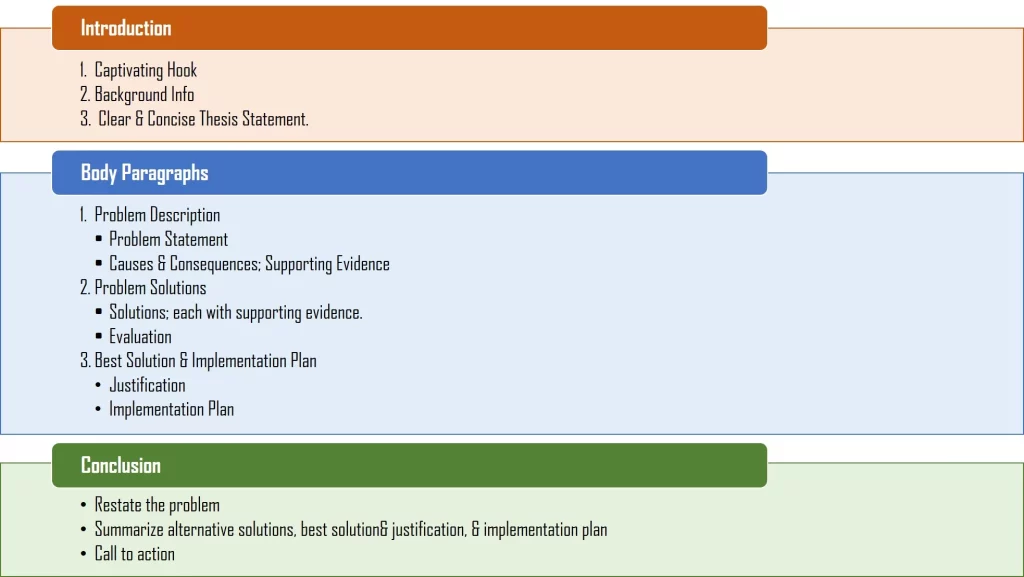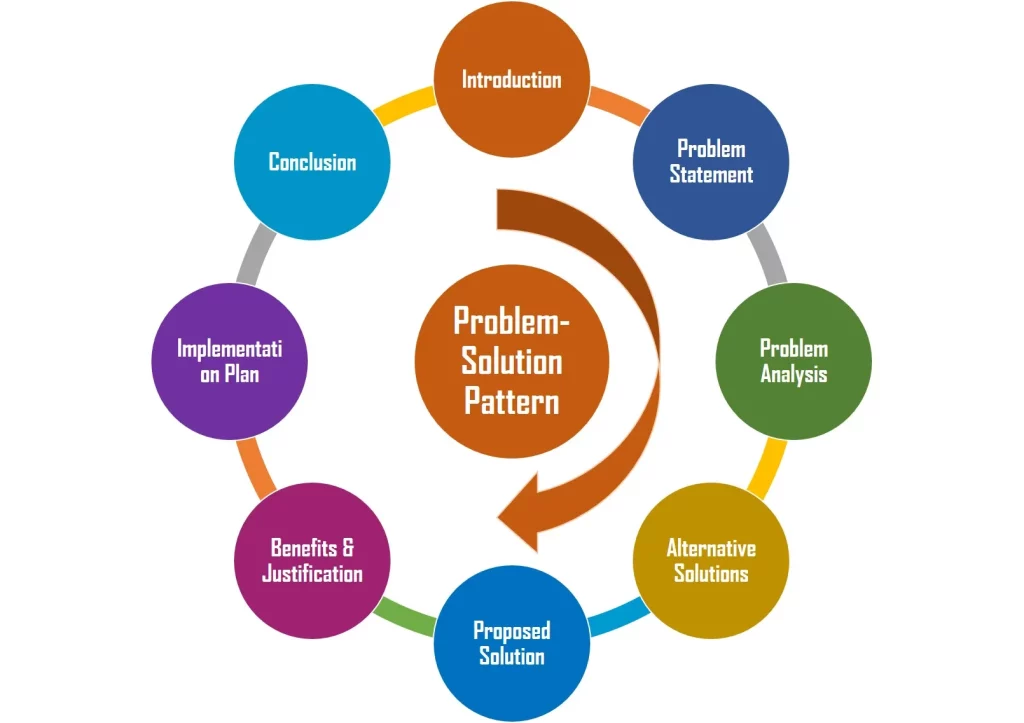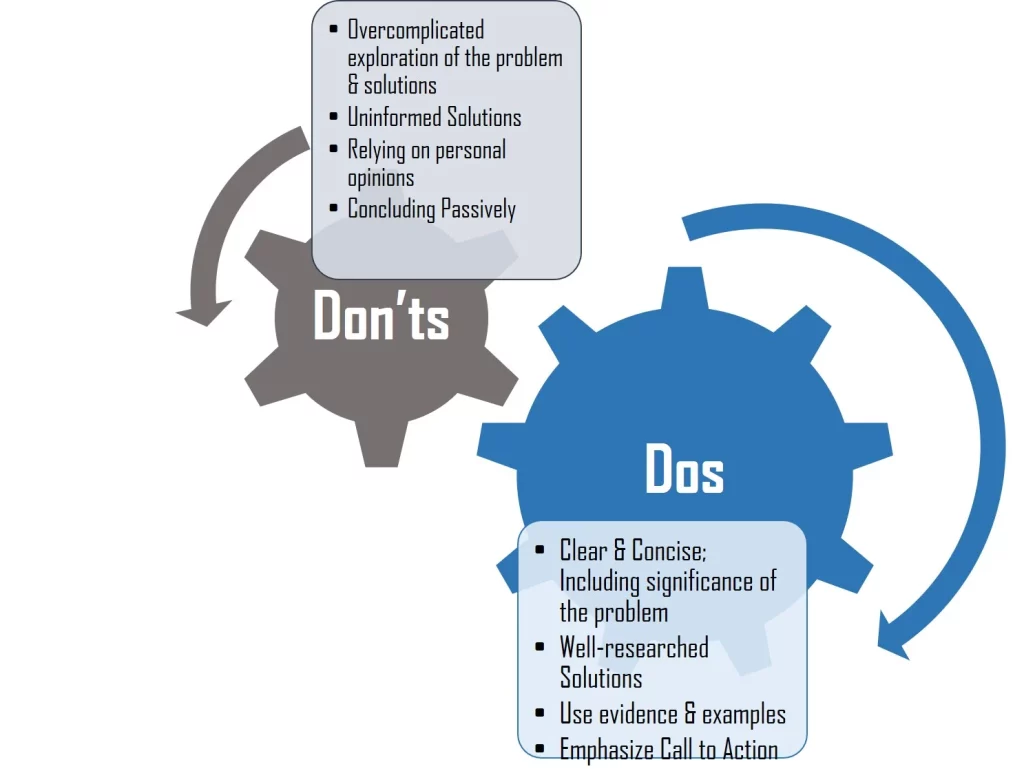
A problem-solution essay is a type of academic paper or writing task in which you identify a specific problem, analyze it in detail, and propose a practical and effective solution or set of solutions to address that problem. This type of essay is commonly assigned in various academic disciplines, including business, engineering, social sciences, and humanities, as well as in real-world contexts, such as policy reports and business proposals.
Here are well-written sample problem-solution essays tailored for college students:
Sample Problem-Solution Essay on Pollution
Sample Problem-Solution Implementation Essay on Unemployment
Key Elements
Key elements of a problem-solution essay include:
- Identification of a Problem: Clearly define and describe the problem you intend to address. The problem should be specific, relevant, and well-defined. It can be a real-world issue, a societal concern, a business challenge, or an academic problem.
- Analysis of the Problem: Provide a thorough analysis of the problem, explaining its causes, consequences, and significance. Use facts, evidence, data, and relevant research to support your analysis.
- Proposal of Solutions: Present one or more potential solutions to the problem. These solutions should be practical, feasible, and well-supported by evidence. Consider the implications, costs, and benefits of each proposed solution.
- Evaluation of Solutions: Analyze and compare the proposed solutions, discussing their strengths and weaknesses. Explain why your chosen solution(s) is the most effective and viable.
- Implementation Plan: If applicable, outline a plan for implementing the solution. Consider the steps, resources, and timeline needed to put your solution into practice.
- Counterarguments: Acknowledge and address potential counterarguments or objections to your proposed solution(s). Show that you have considered alternative viewpoints and can refute them effectively.
- Conclusion: Summarize the key points of your essay, reiterate the significance of the problem, and emphasize the importance of implementing your proposed solution(s).
Problem-solution essays are a valuable form of writing because they not only require critical analysis and research skills but also encourage the development of practical solutions to real-world problems. They are often used in academia to assess students’ ability to identify and address complex issues and in professional contexts to inform decision-making and policy development.
General Outline

The format of a problem-solution essay typically follows a structured outline to ensure clarity and coherence in presenting the problem, analyzing it, and proposing solutions. Here’s a common format for a problem-solution essay:
- Introduction
- Hook: Begin with an engaging opening sentence or question to grab the reader’s attention.
- Background Information: Provide context or background information about the problem you are addressing.
- Thesis Statement: Clearly state the specific problem and your proposed solution(s) or approach to solving it.
- Problem Description
- Problem Statement: Clearly and concisely describe the problem, its scope, and its significance. Use facts, data, and evidence to support your claims.
- Causes and Consequences: Analyze the root causes of the problem and discuss its consequences on individuals, society, or the relevant context.
- Evidence: Provide relevant statistics, examples, or case studies to illustrate the severity and impact of the problem.
- Proposed Solutions
- Solution 1: Present the first proposed solution or approach to addressing the problem. Explain how it works and why it is effective.
- Solution 2: If applicable, introduce additional solutions in separate paragraphs. Explain each solution’s benefits and feasibility.
- Supporting Details: Provide evidence, examples, or expert opinions to support the effectiveness of each proposed solution.
- Evaluation: Discuss the advantages and disadvantages of each solution, including potential challenges and limitations.
- Best Solution and Implementation Plan
- Best Solution: Choose the most effective solution from the options presented in the previous section. Explain why this solution is the most practical and impactful.
- Implementation Plan: Outline a plan for implementing the chosen solution. Include steps, resources, timelines, and any necessary considerations.
- Anticipating Objections: Address potential objections or counterarguments to your chosen solution and refute them effectively.
- Conclusion
- Restate the Problem: Summarize the key points of the problem you discussed.
- Restate the Solution: Recap the chosen solution and its benefits.
- Call to Action: Emphasize the importance of taking action to solve the problem and encourage the reader or relevant stakeholders to act.
- Closing Statement: End with a thought-provoking statement or a call for reflection on the significance of addressing the problem.
- References (if applicable)
- Include a list of references or citations for any sources used in the essay, following the appropriate citation style (e.g., APA, MLA, Chicago).
- Follow the guidelines provided by your college or academic institution.
This outline provides a structured framework for organizing your problem-solution essay, ensuring that you effectively present the problem, propose practical solutions, and provide supporting evidence and analysis.
How to Write: Steps
Writing a problem-solution essay involves addressing a specific issue or problem, proposing potential solutions, and persuading readers to accept your proposed solutions. Here’s a step-by-step guide on how to write a problem-solution essay:
- Choose a Relevant Topic:
- Select a problem or issue that is current, significant, and relevant. It should be something you are passionate about or have knowledge of.
- Review our comprehensive list of suitable topics for problem-solution essays.
- Research the Problem:
- Gather information about the problem through research. Understand its causes, effects, and the context in which it exists.
- Use credible sources such as articles, books, reports, and academic journals.
- Outline and Organize Your Essay: Use a clear and logical structure for your essay. A common structure includes an introduction, body paragraphs, and a conclusion. The outline helps students map the claims and evidence that will support the thesis statement and how they will connect
- Start with a hook to grab the reader’s attention. You can use statistics, anecdotes, or a thought-provoking question.
- Present the problem and its significance: Define the problem clearly. Provide a clear and concise definition of the problem. Explain why it matters and why it requires attention.
- Provide a thesis statement that previews the solutions you will discuss.
- Write Effective Body Paragraphs:
- Each body paragraph should focus on one solution or aspect of the problem.
- Propose Solutions: Identify potential solutions or strategies to address the problem. Consider different approaches and evaluate their feasibility, effectiveness, and ethical implications. Explain the solution in detail, including how it works and why it is a viable option.
- Provide evidence, examples, statistics, or expert opinions to support your claims. Use specific examples, case studies, anecdotes, or stories to illustrate the problem and the effectiveness of your solutions.
- Address potential counterarguments and refute them, demonstrating the strength of your solution.
- Propose the best solution among identified alternatives. Explain using evidence why the selected solution is the most ideal for this problem.
- If required, discuss a potential implementation plan for the ideal solution.
- Employ persuasive techniques such as ethos (credibility), pathos (emotion), and logos (logic) to convince your audience.
- Use clear and concise language, avoiding jargon or overly technical terms.
- Write a Strong Conclusion:
- Summarize the main points of your essay.
- Reiterate the importance of solving the problem.
- Call for action or provide a compelling reason for readers to support your proposed solutions.
- Leave a lasting impression on the reader.
- Revise and Edit:
- Review your essay for clarity, coherence, and grammar errors.
- Ensure that your ideas flow logically from one paragraph to the next.
- Check for proper citation and formatting if you used external sources.
- Seek Feedback: Have someone else read your essay to get feedback on its clarity and persuasiveness.
- Finalize Your Essay:
- Make any necessary revisions based on feedback.
- Proofread for spelling and punctuation errors.
- Format your essay according to the specified guidelines (e.g., MLA, APA).
Writing a problem-solution essay requires careful research, clear organization, and persuasive writing techniques. By following these steps, you can effectively address a problem, propose solutions, and persuade your readers to take action.
Dos & Don’ts

Below are the most essential considerations when writing a problem-solution essay, along with dos and don’ts:
- Use Clear and Concise Language vs. Don’t Overcomplicate
- Do: Use straightforward language to convey your ideas clearly. Be concise and get to the point without unnecessary verbosity.
- Don’t: Overcomplicate your language with jargon, complex sentences, or excessive vocabulary that may confuse readers.
- Address the Problem’s Significance vs. Don’t Underestimate the Importance
- Do: Clearly explain the significance and relevance of the problem you’re addressing. Convince readers of the problem’s importance and why it requires attention.
- Don’t: Downplay or underestimate the problem’s impact or relevance.
- Provide Evidence and Examples vs. Don’t Rely Solely on Assumptions
- Do: Support your problem description and proposed solutions with credible evidence, data, research, or real-world examples. Use facts and statistics to substantiate your claims.
- Don’t: Base your arguments solely on assumptions or personal opinions without credible backing.
- Present Well-Researched Solutions vs. Don’t Propose Uninformed Solutions
- Do: Propose solutions that are well-researched, feasible, and supported by evidence. Consider the practicality and potential effectiveness of each solution.
- Don’t: Suggest solutions that lack research, evidence, or practicality.
- Address Counterarguments vs. Don’t Ignore Alternate Perspectives
- Do: Acknowledge potential counterarguments or objections to your proposed solutions. Provide a thoughtful response to counterarguments, demonstrating that you’ve considered different viewpoints.
- Don’t: Ignore or dismiss opposing viewpoints without addressing them.
- Consider Implementation vs. Don’t Leave Solutions Theoretical
- Do: Outline an implementation plan for your proposed solution(s), considering steps, resources, and timelines. Address potential challenges and considerations for successful implementation.
- Don’t: Leave your solutions as theoretical ideas without discussing how they can be put into practice.
- Emphasize the Call to Action vs. Don’t Conclude Passively
- Do: End your essay with a strong call to action, urging readers or relevant stakeholders to take steps to address the problem. Highlight the urgency and importance of implementing your proposed solutions.
- Don’t: Conclude passively without emphasizing the need for action or change.
By following these dos and don’ts specific to problem-solution essays, you can effectively communicate your analysis of the problem and your proposed solutions while engaging and persuading your audience.
Frequently Asked Questions (F.A.Qs)
Here are answers to frequently asked questions about problem-solution essays:
-
How does a problem-solution essay differ from a proposal essay?
While both essays propose solutions, a problem-solution essay primarily focuses on addressing a specific problem or issue and then providing practical solutions. In contrast, a proposal essay may propose various ideas or plans, not necessarily tied to a specific problem.
-
How do I choose a relevant and compelling issue to address in my problem solution essay?
Choose an issue that is current, significant, and meaningful to your audience. Look for problems that have practical solutions and can lead to positive change. Consider your own interests and expertise as well.
-
How do I effectively analyze and present the problem in my essay?
- Present a clear and concise problem statement in your introduction, providing background and context.
- Analyze the problem by explaining its causes, effects, and any relevant data or evidence that supports your description.
-
What strategies can I use to propose practical solutions to the identified problem?
Propose solutions that are specific, realistic, and actionable. Consider the feasibility and potential effectiveness of each solution. Explain how and why your solutions address the problem effectively.
-
Should I consider counterarguments in a problem solution essay, and how do I address them?
Yes, acknowledging counterarguments shows that you’ve considered various perspectives. Address counterarguments by presenting a rebuttal or by demonstrating why your proposed solutions are more effective or practical.
-
What role does research and evidence play in supporting my proposed solutions?
Research and evidence add credibility to your proposed solutions. Use statistics, expert opinions, case studies, and examples to support your arguments and show that your solutions are well-founded.
-
How do I create a strong conclusion that leaves a lasting impact in a problem solution essay?
- Summarize the main points of your essay, emphasizing the importance of your solutions.
- Reinforce the positive impact they can have.
- End with a call to action or a thought-provoking statement that motivates readers to consider your solutions seriously.
-
Are there specific techniques for making my problem solution essay persuasive and actionable?
- Use persuasive techniques such as emotional appeal, logical reasoning, and credibility to convince your audience of the viability of your solutions.
- Be clear, concise, and passionate in your writing to engage your readers.
-
How can I revise and edit my essay to ensure it is well-organized and error-free?
Review your essay for clarity, coherence, grammar, and spelling errors. Ensure that your essay flows logically from the problem presentation to the proposed solutions. Consider seeking feedback from peers or a writing tutor for improvements.
Remember, the key to writing a successful problem-solution essay is to thoroughly understand and present the problem, propose practical and well-researched solutions, and persuasively argue for the effectiveness of those solutions. Effective research, clear organization, persuasive language, and a focus on actionable solutions are essential elements for success.



